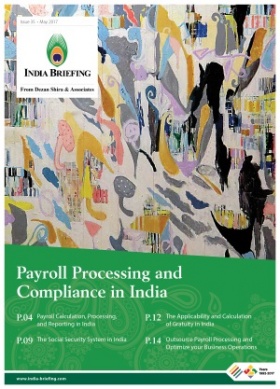Business Branding versus Economic Reforms: An Updated View of Modi’s India
The Modi government’s win in various state elections last month, including the prized state of Uttar Pradesh, demonstrates the powerful and enduring appeal of the Prime Minister. This is clear as the Bharatiya Janata Party (BJP) projected PM Modi as the face of all its state level campaigns, running on platforms that showcased his ‘proven’ track records.
In the past few months, Modi has managed to win mass favor as he doubled down on his 2016 decision to demonetize the 500 and 1000 currency notes in his ‘fight against black money’. Yet, while his attempts to rebrand India as a global manufacturing and investment hub have garnered global attention, many have been surprised at the slow pace of reforms given Modi’s historic mandate.
In this article, we break down some of the factors that shape India’s current business landscape by identifying what reforms have been passed, the growth of state-based reforms, and the reasons why the federal government has faltered on some of Modi’s more ambitious proposals.
Reforms implemented
- Goods and Services Tax (GST) Bill, which will be in effect from July 1;
- Single, digitized windows for starting a business and complying with labor laws;
- Commercial courts established to expedite commercial disputes;
- Liberalization of the foreign direct investment (FDI) policy; most sectors converted to the automatic approval route;
- Rationalized bankruptcy and insolvency policies; consolidates existing laws to deal with insolvency while regulating insolvency professionals and introduces a time limit on the bankruptcy process; and,
- Introduced Intellectual Property Rights (IPR) Bill.
The strength of these impressive reforms now needs to be bolstered by proper implementation and enforcement. For instance, while a single window exists for opening a business, business owners still have to go through a stifling number of procedures, often subjected to unnecessary delays, to open a business. To transform India’s business environment, the federal government needs to ensure efficiency at the operative level – securing approvals, permits, and speeding up processing times.
In September 2014, PM Modi announced his ‘Make in India’ campaign – an initiative that seeks to kick-start India’s lagging manufacturing sector. While billions of dollars have begun to enter India, a stronger manufacturing ecosystem is needed for India to actually compete with its regional manufacturing rivals. Key areas like tax reform, contract compliance, cross-border agreements, and construction regulation need to be supported with improved logistics infrastructure as well as internet connectivity to make India’s manufacturing ecosystem a compelling proposition for foreign investors.
Indeed, two major reforms vital to establishing India as a global manufacturing hub – land acquisition and labor relations – remain elusive for the federal government. Nevertheless, these reforms are seeing greater success in individual states.
Ease of doing business in India
Unlike at the federal level, some states have taken up the challenge to reform labor and land regulations. Individual states have begun drafting and passing their own amendments to the 2013 Land Bill as well as simplifying labor laws to help businesses open and maintain smaller factories. The states of Rajasthan, Gujarat, Tamil Nadu, Andhra Pradesh, and recently created Telangana are leading these reform initiatives.
While India did not make significant gains in the World Bank’s 2017 Doing Business Report (DBR), individual states are attracting investors and manufacturers on their home turf through state-specific reforms and policies. According to a joint initiative between the World Bank and the Department of Industrial Policy and Promotion (DIPP), 16 Indian states have implemented over 75 percent of the 340 reforms proposed by the DIPP’s Business Reform Action Plan in 2015-2016.
Furthermore, the central government of India has empowered and directed state authorities to make their states more business friendly. Through Article 254(2) of the Indian constitution, states can make their own legislative changes on issues concurrently governed by states and the center – pending a signed approval from the president. The federal government of India has operationalized this rarely used clause to nurture a competitive spirit among states – allowing individual states to experiment with new legislation, which other states may emulate while simultaneously ranking states on their progress implementing business reforms.
Potential for state-based change: A look at Rajasthan
States often have an easier time passing through legislation that would otherwise be entangled in controversy at the federal level. State assemblies do not garner the same media attention as federal decisions do. Further, given the relatively smaller size of a state assembly versus the parliament, state votes take less time, and can manage opposition more easily.
Rajasthan, for instance, has been able to side step barriers to reforms that the federal government has failed to accomplish. The Rajasthan Assembly recently passed state-level amendments, which essentially relax several labor laws: allowing factories with up to 300 workers to retrench employees without government permission, and increasing the eligible workforce required to unionize from 15 percent to 30 percent.
Rajasthan has also ushered in a significant wave of land reform. Under these reforms it is now easier for land owners to sublet or lease part or all of their land to solar and wind power companies (providing much needed space for an expanding wind and solar energy sector); the state government can acquire land in the Delhi-Mumbai Industrial Corridor (40 percent of which falls within the borders of Rajasthan); and an expedited process of land acquisition complemented with statutory backing to land records (effectively guaranteeing land and property ownership).
Additionally, Rajasthan has established three Special Economic Zones (SEZ): a SEZ for jewelry in Jaipur, handicrafts in Jodhpur, and a multi-product SEZ in Mahindra World City. Rajasthan has also developed Japanese and Korean industrial zones to boost trade with the two respective countries.
Challenges at the federal level
The Modi government’s staggered performance on reforms can be explained on two fronts. On one hand, the federal government faces roadblocks propped by opposition parties in the upper house of parliament where Modi’s BJP party is not in majority. Secondly, internal conflicts within the ruling party itself weaken the government’s intent. The Hindu right-wing Rashtriya Swayamsevak Sangh (RSS), for example, is considered to be the BJP’s ideological parent and often expresses strong anti-globalization sentiments, which run up against liberalizing projects. The RSS enjoys considerable influence over the BJP with many of its members affiliated with the organization, including PM Modi himself having risen through the RSS cadres.
As India’s prospects rise, states lead the way
The regulatory landscape in India is changing with a concentrated effort on improving the ease of doing business. The federal government of India as a whole, however, has not always shown consistency in implementing significant economic reforms. However, a closer look at the interplay between states and the federal government is promising, and foreign investors and companies looking to do business in India should take a regional approach – targeting areas where federal policies complement those of state based reform.
About Us
India Briefing is published by Asia Briefing, a subsidiary of Dezan Shira & Associates. We produce material for foreign investors throughout Eurasia, including ASEAN, China, Indonesia, Russia, the Silk Road, & Vietnam. For editorial matters please contact us here and for a complimentary subscription to our products, please click here.
Dezan Shira & Associates provide business intelligence, due diligence, legal, tax and advisory services throughout India and the Asian region. We maintain offices in Delhi and Mumbai and throughout China, South-East Asia, India, and Russia. For assistance with India investment issues or into Asia overall, please contact us at india@dezshira.com or visit us at www.dezshira.com.
- Previous Article Navigating HR Due Diligence in India
- Next Article India Regulatory Brief: India-Cyprus DTAA in Effect, GST Taxpayers to be Rated on Compliance












